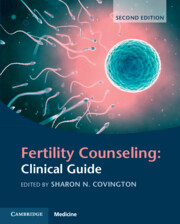Book contents
- Fertility Counseling: Clinical Guide
- Fertility Counseling: Clinical Guide
- Copyright page
- Dedication
- Contents
- Preface
- Contributors
- I Introduction
- II Therapeutic Approaches
- III Third Party Reproduction: Assessment and Preparation
- Chapter 9 Counseling Recipients of Nonidentified Donor Gametes
- Chapter 10 Counseling Nonidentified Gamete Donors
- Chapter 11 Counseling Embryo Donors and Recipients
- Chapter 12 Special Considerations in Gestational Surrogacy Assessments and Arrangements
- Chapter 13 DNA and the End of Anonymity: Disclosure, Donor-Linkage and Fertility Counseling
- Chapter 14 Family Life after Donor Conception
- IV Addressing the Needs of Diverse Populations
- V Special Topics in Fertility Counseling
- VI Practice Issues
- The International Glossary on Infertility and Fertility Care, 2017
- Index
- References
Chapter 11 - Counseling Embryo Donors and Recipients
from III - Third Party Reproduction: Assessment and Preparation
Published online by Cambridge University Press: 24 November 2022
- Fertility Counseling: Clinical Guide
- Fertility Counseling: Clinical Guide
- Copyright page
- Dedication
- Contents
- Preface
- Contributors
- I Introduction
- II Therapeutic Approaches
- III Third Party Reproduction: Assessment and Preparation
- Chapter 9 Counseling Recipients of Nonidentified Donor Gametes
- Chapter 10 Counseling Nonidentified Gamete Donors
- Chapter 11 Counseling Embryo Donors and Recipients
- Chapter 12 Special Considerations in Gestational Surrogacy Assessments and Arrangements
- Chapter 13 DNA and the End of Anonymity: Disclosure, Donor-Linkage and Fertility Counseling
- Chapter 14 Family Life after Donor Conception
- IV Addressing the Needs of Diverse Populations
- V Special Topics in Fertility Counseling
- VI Practice Issues
- The International Glossary on Infertility and Fertility Care, 2017
- Index
- References
Summary
Embryo donation is a unique and novel disposition option and family-building choice for patients. While there are an estimated one million surplus embryos cryopreserved around the world, embryo donation cases remain low. At the same time, interest in embryo donation is on the rise, as an increasing number of patients consider alternative methods of family creation. The heightened interest in embryo donation necessitates skilled fertility counselors to provide education and counseling to patients on both the donor and recipient side. Potential embryo donors often struggle with decision making around the disposition of their remaining embryos, while potential recipients may grapple with the notion of nongenetic parenting and their relationship to their donors and their donor-conceived children. The fertility counselor can play an integral role in helping patients navigate their decision making and their new relationships and family structure. This chapter explores the historical, logistical, psychosocial and relational considerations of embryo donation. The chapter highlights the important role of the fertility counselor throughout an embryo donation journey, and offers frameworks, best practices, and therapeutic tools that counselors can utilize as they work to support their patients.
Keywords
- Type
- Chapter
- Information
- Fertility Counseling: Clinical Guide , pp. 115 - 124Publisher: Cambridge University PressPrint publication year: 2022

